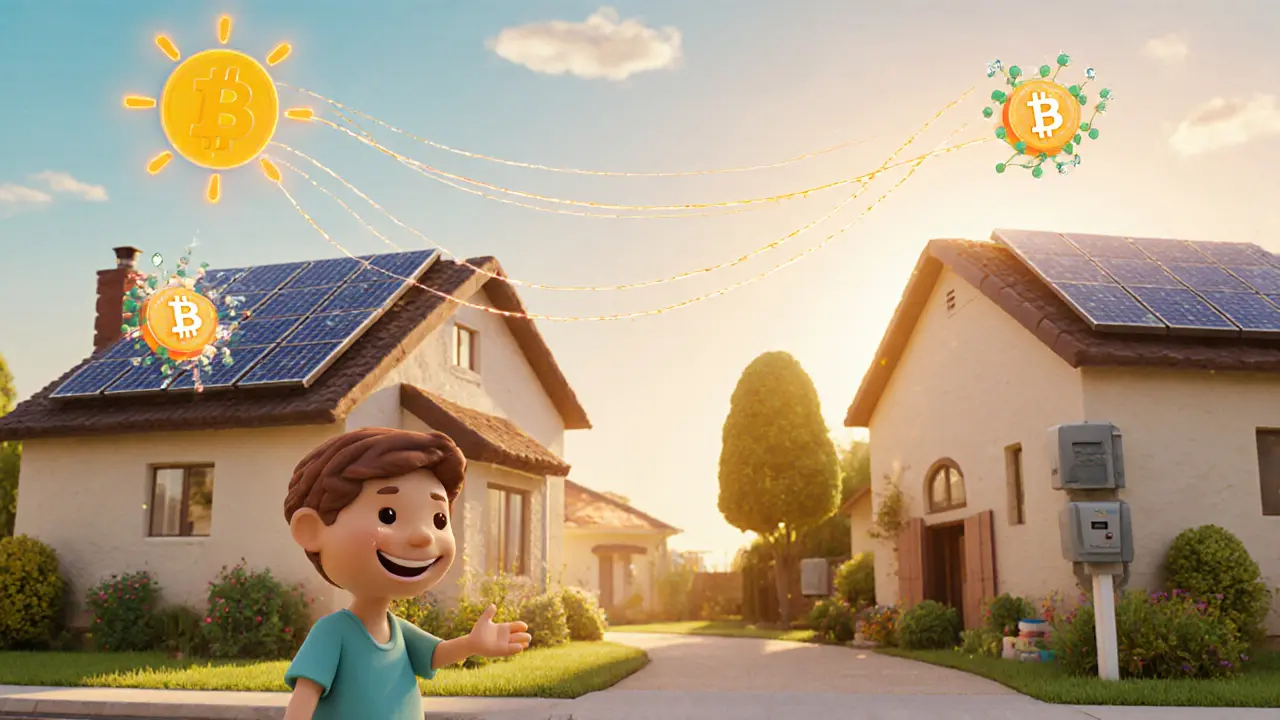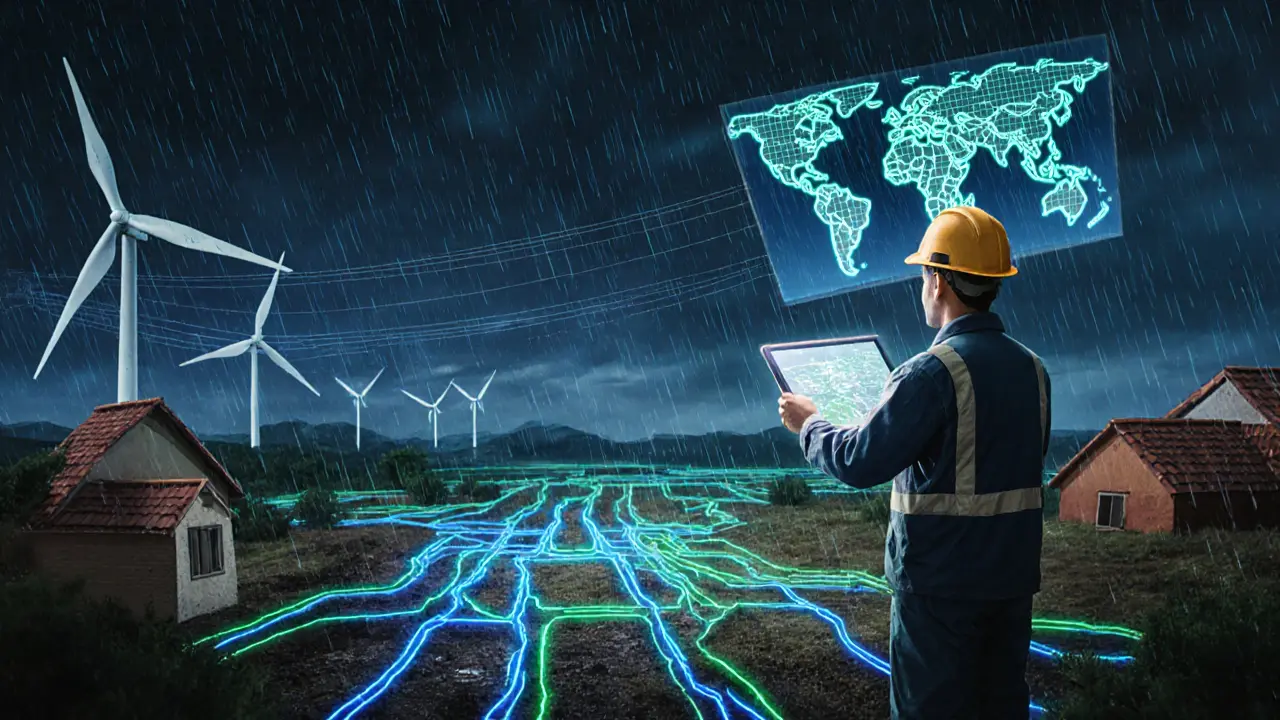How Blockchain Enables Energy Markets
 Jun, 13 2025
Jun, 13 2025
Solar Energy Trading Earnings Calculator
Calculate Your Solar Energy Revenue
Estimate how much you could earn by selling excess solar power through blockchain platforms like LO3 Energy or Power Ledger.
Imagine your neighbor sells excess solar power directly to you-no utility company, no middleman, no complex billing. Just a quick, secure, and transparent transaction recorded on a digital ledger. This isn’t science fiction. It’s happening right now, thanks to blockchain.
What Blockchain Actually Does in Energy Markets
Blockchain isn’t just about Bitcoin. In energy, it’s a digital ledger that records every kilowatt-hour produced, consumed, or traded. Unlike traditional systems where a central utility controls everything, blockchain lets households, businesses, and even solar farms trade energy directly with each other. Each transaction is time-stamped, encrypted, and stored across hundreds of computers. No single entity can change it. That’s the core: trust without a middleman. This matters because energy markets have been stuck in a 20th-century model. Power flows one way-from giant plants to homes. But with solar panels on rooftops and home batteries everywhere, energy now flows in all directions. The grid needs to adapt. Blockchain makes that possible.How Peer-to-Peer Energy Trading Works
In a typical neighborhood with solar panels, some homes produce more energy than they use. Without blockchain, that extra power either gets sold back to the utility at a low rate or goes to waste. With blockchain, those homes can sell directly to neighbors who need it. Here’s how it works:- A smart meter tracks how much solar energy your system produces in real time.
- A smart contract-code that runs automatically on the blockchain-detects when you have surplus power.
- The system offers that power to nearby buyers at a price you set.
- When someone accepts, the energy flows instantly, and payment is made in cryptocurrency or local credits.
- The entire transaction is recorded on the blockchain-permanent, public, and tamper-proof.
Renewable Energy Certificates and Carbon Credits Made Transparent
Tracking whether a company actually uses renewable energy has always been messy. Utilities claim they’re green, but proving it? Hard. That’s where blockchain changes the game. Renewable Energy Certificates (RECs) are digital tokens that represent one megawatt-hour of clean energy generated. Traditionally, these were paper-based or stored in centralized databases-easy to fake or double-sold. Blockchain fixes that. Each REC is now tokenized on a blockchain. When a wind farm generates power, a digital token is created and linked to that exact unit of energy. It can’t be copied. It can’t be deleted. When a company buys it to claim they’re using green power, the transaction is public and verifiable. The same applies to carbon credits. Farmers who plant trees or ranchers who reduce methane emissions can now tokenize their carbon capture. Companies like Microsoft and Shell are buying these tokens to offset emissions. Blockchain ensures these credits are real, not just marketing fluff.
Smart Grids and Automation Through Smart Contracts
The power grid is under stress. Extreme weather, aging infrastructure, and sudden spikes in demand make it hard to balance supply and demand. Blockchain, combined with IoT sensors and AI, is making grids smarter. Smart contracts can automatically adjust energy flow based on real-time data:- If a heatwave hits and demand spikes, contracts can trigger home batteries to discharge into the grid.
- If a solar farm’s output drops due to clouds, contracts can instantly switch to nearby wind turbines.
- If a household is on a time-of-use plan, contracts can turn off non-essential appliances during peak hours.
Who’s Using This Today?
The adoption isn’t scattered-it’s concentrated in key areas:- Commercial buildings (45% of blockchain energy use in 2025) use it to cut energy costs and meet sustainability targets.
- Residential users saw a 20% jump in 2025 as more homeowners added solar panels and batteries.
- Utilities (35% market share) are testing blockchain for grid balancing and fraud prevention.
- Industrial sites with high energy needs are using it to track renewable usage for compliance and tax incentives.

Energy Cryptocurrencies and New Incentives
Some projects are going further-creating their own digital currencies to reward clean energy production. SolarCoin, for example, gives one token for every megawatt-hour of solar energy generated. Producers can trade it, hold it, or cash it out. It’s not just a reward-it’s a new economic layer that turns clean energy into a financial asset. In rural Kenya, startups are using blockchain to let farmers sell excess solar power from microgrids to nearby villages. They get paid in digital tokens that can be used to buy food, pay school fees, or recharge phones. This isn’t just about energy-it’s about economic inclusion.Challenges and Risks
Blockchain isn’t magic. It has real problems:- Security risks: Smart contracts can be hacked. In 2024, a $10 million energy trading platform was drained because of a coding flaw.
- Integration: Most utilities still run on 30-year-old systems. Connecting them to blockchain isn’t easy.
- Regulation: No country has clear rules yet. Who regulates peer-to-peer energy sales? How are taxes handled?
- Scalability: Some blockchains can’t handle thousands of transactions per second. Energy markets need speed.
The Future: Blockchain as Infrastructure
By 2035, the blockchain energy market could be worth over $140 billion. That’s not hype-it’s a projection from industry analysts who’ve tracked adoption for a decade. The next phase won’t be about flashy startups. It’ll be about integration. Blockchain will become the invisible backbone of energy systems-like the internet is today. You won’t see it. But you’ll feel it:- Your electric bill drops because you’re trading with neighbors.
- Your city’s grid never blacks out during storms.
- You know your EV charger is powered by wind, not coal-because the blockchain proves it.
Can blockchain really replace utility companies?
Not entirely-but it reduces their monopoly. Utilities will still manage the physical grid, maintain transmission lines, and handle emergencies. But blockchain lets consumers trade energy directly, cutting out the middleman for routine transactions. Think of utilities as road operators and blockchain as the GPS that lets drivers choose the best route.
Do I need special equipment to use blockchain energy trading?
Yes. You need a smart meter that connects to the internet and a compatible energy management system. Most modern solar installations include this. If you’re in a pilot program (like in Brooklyn or Australia), the provider will supply the tools. For most homeowners, it’s as simple as installing an app and linking your meter.
Is blockchain energy trading legal?
It’s legal in many places, but regulations vary. In the U.S., states like New York and California have approved peer-to-peer trading pilots. In Europe, Germany and the Netherlands have clear rules. But in many countries, it’s still in a gray zone. Always check local utility and energy commission guidelines before participating.
How secure is blockchain for energy transactions?
Blockchain itself is extremely secure-it’s nearly impossible to alter past transactions. But the weak points are the software around it: smart contracts, apps, and wallets. A poorly coded contract can be hacked. That’s why audits and multi-signature wallets are essential. Always choose platforms with third-party security certifications.
Can blockchain help reduce my carbon footprint?
Absolutely. By enabling direct access to renewable energy and eliminating inefficient transmission losses, blockchain reduces waste. Plus, tokenized carbon credits let you verify that your energy use supports real environmental projects. If you’re buying power from a local solar farm instead of a coal plant, your footprint drops immediately.
Ian Esche
November 27, 2025 AT 12:25Let’s be real-this blockchain energy crap is just another way for tech bros to dodge taxes and avoid paying for real infrastructure. We’ve got actual power lines that need fixing, not some crypto fantasy where your neighbor sells you solar power like it’s a TikTok coin. The grid isn’t a decentralized app, it’s a public good. Stop trying to turn electricity into a NFT.
And don’t even get me started on ‘energy cryptocurrencies.’ SolarCoin? That’s not a currency, that’s a scam waiting for a SEC investigation. We don’t need more digital glitter-we need a national grid upgrade that doesn’t rely on code written by 19-year-olds in their parents’ basements.